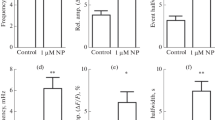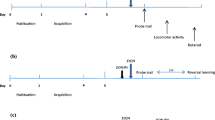Abstract
The effects of the centrally acting cholinesterase (ChE) inhibitors, tetrahydroaminoacridine (THA) and E2020 (1-benzyl-4-[(5,6-dimethoxy-l-indanon)-2-yl] methylpiperidine hydrochloride), potential drugs for the treatment of senile dementia, on the basal extracellular acetylcholine (ACh) concentration in the hippocampus of freely moving rats, were determined using a microdialysis technique without the use of a ChE inhibitor in the perfusion fluid and a sensitive RIA. The mean (±SEM) basal ACh content in the perfusate was 103.1 ± 3.6 fmol/sample collected over 30 min when microdialysis probes with a length of 3 mm dialysis membrane were used. The content of ACh decreased to an almost undetectable level upon perfusion of magnesium, suggesting that, in the present study, most of the ACh detected in the perfusates was due to cholinergic neuronal activity. THA (1.65 mg/kg, i.p.) produced an insignificant increase in the extracellular ACh concentration, but a dose of 5 mg/kg, i.p. caused a prolonged and significant 5.5-fold increase from the control value. E2020 (0.65 and 2 mg/kg, i.p.) produced significant, prolonged and dose-dependent increases (4 and 12 times the control value, respectively), the peak effect occurring within 1 h. Perfusion with 10 μmol/l physostigmine produced an about 30-fold increase of ACh output, suggesting that the basal extracellular ACh concentration is highly dependent on ChE activity. When ChE was inhibited locally by perfusion with physostigmine, THA (5 mg/kg) produced a transient and, at its maximum, a 1.42-fold increase in extracellular ACh concentration. These results demonstrate that the basal, physiological, extracellular ACh concentration in the hippocampus of freely moving rats can be determined using a microdialysis technique and a sensitive RIA, and suggest that THA and E 2020 increase ACh concentration in the synaptic cleft of the hippocampus in a dose-dependent manner mostly through ChE inhibition.
Similar content being viewed by others
References
Bartus RT, Dean RL, Beer B, Lippa AS (1982) The cholinergic hypothesis of geriatric memory dysfunction. Science 217:408–417
Benveniste H, Drejer J, Schousboe A, Diemer NH (1987) Regional cerebral glucose phosphorylation and blood flow after insertion of a microdialysis fiber through the dorsal hippocampus in the rat. J Neurochem 49:729–734
Bolton S (1984) Pharmaceutical statistics: practical and clinical applications. Dekker, New York Basel
Brinkman SD, Gershon S (1983) Measurement of cholinergic drug effects on memory in Alzheimer's disease. Neurobiol Aging 4:139–145
Collerton D (1986) Cholinergic function and intellectual decline in Alzheimer disease. Neuroscience 19:1–28
Damsma G, Westerink BHC, Imerato A, Pollema H, de Vries JB, Horn AS (1987) Automated brain dialysis of acetylcholine in freely moving rats: detection of acetylcholine. Life Sci 41:873–876
Davis KL, Mohs RC (1982) Enhancement of memory processes in Alzheimer's disease with multiple-dose intravenous physostigmine. Am J Psychiat 139:1421–1424
Dunnett SB, Low WC, Iversen SD, Stenevi U, Björklund A (1982) Septal transplants restore maze learning in rats with fornix-fimbria lesions. Brain Res 251:335–348
Farlow MF, Gracon SI, Hershey LA, Lewis KW, Sadowsky CH, Dolan-Ureno J (1992) A controlled trial of tacrine in Alzheimer's disease. JAMA 268:2523–2529
Farr RS (1958) A quantitative immunochemical measure of the primary interaction between I* BSA and antibody. J Infect Dis 103:239–262
Francis PT, Palmer AM, Sims NR, Bowen DM, Davison AN, Esiri MM, Neary D, Snowden JS, Wilcock GK (1985) Neurochemical studies of early-onset Alzheimer's disease. Possible influence on treatment. N Engl J Med 313:7–11
Hunter AJ, Murray TK, Jones JA, Cross AJ, Green AR (1989) The cholinergic pharmacology of tetrahydroaminoacridine in vivo and in vitro. Br J Pharmacol 98:79–86
Kametani H, Kawamura H (1991) Circadian rhythm of cortical acetylcholine release as measured by in vivo microdialysis in freely moving rats. Neurosci Lett 132:263–266
Kawashima K, Ishikawa H, Mochizuki M (1980) Radioimmunoassay for acetylcholine in the rat brain. J Pharmacol Methods 3:115–123
Kawashima K, Hayakawa T, Kashima Y, Suzuki T, Fujimoto K, Oohata H (1991) Determination of acetylcholine release in the striatum of anesthetized rats using in vivo microdialysis and a radioimmunoassay. J Neurochem 57:882–887
Kosaka T, Yamanishi Y, Ogura H, Yamatsu K (1990) Effects of E2020 on the extracellular level of acetylcholine in the rat cerebral cortex measured by microdialysis without addition of cholinesterase inhibitor. Eur J Pharmacol 183 [Suppl]:1936
Messamore E, Ogane N, Giacobini E (1993a) Cholinesterase inhibitor effects on extracellular acetylcholine in rat striatum. Neuropharmacology 32:291–296
Messamore E, Warpman U, Ogane N, Giacobini E (1993b) Cholinesterase inhibitor effects on extracellular acetylcholine in rat cortex. Neuropharmacology 32:745–750
Mizuno T, Endo Y, Arita J, Kimura F (1991) Acetylcholine release in the rat hippocampus as measured by the microdialysis method correlates with motor activity and exhibits a diurnal variation. Neuroscience 44:607–612
Mohs RC, Davis BM, Greenwald BS, Mathe AA, Johns CA, Horvath TB, Davis KL (1985) Clinical studies of the cholinergic deficit in Alzheimer's disease. II. Psychopharmacologic studies. J Am Geriatr Soc 33:749–757
Ogura H, Kosaka T, Araki S, Yamanishi Y, Yamatsu K (1988) Behavioral study of E2020, a novel centrally acting acetylcholinesterase inhibitor. Soc Neurosci Abstr 14:60
Paxinos G, Watson C (1986) The rat brain in stereotaxic coordinates, 2nd edn. Academic Press, Sydney
Pearce BD, Potter LT (1988) Effects of tetrahydroaminoacridine on M1 and M2 muscarine receptors. Neurosci Lett 88:281–285
Pohorecki R, Head R, Domino EF (1987) Effect of selected muscarinic cholinergic antagonists on [3Hlacetylcholine release from rat hippocampal slices. J Pharmacol Exp Ther 244:213–217
Potter PE, Meek JL, Neff NH (1983) Acetylcholine and choline in neural tissue measured by HPLC with electrochemical detection. J Neurochem 41:188–194
Raiteri M, Leardi R, Marchi M (1983) Heterogeneity of presynaptic receptors regulating neurotransmitter release in the rat brain. J Pharmacol Exp Ther 228:209–214
Rogers SL, Yamanishi Y, Yamatsu K (1991) The pharmacology of piperidine cholinesterase inhibitor. In: Becker R, Giacobini E (eds) Cholinergic basis for Alzheimer therapy. Birkhauser, Boston, pp 314–320
Stevens DR, Cotman CW (1987) Excitatory actions of tetrahydro-9-aminoacridine (THA) on hippocampal pyramidal neurons. Neurosci Lett 79:301–305
Summers WK, Viesselman JO, Marsh GM, Candelora K (1981) Use of THA in treatment of Alzheimer-like dementia: pilot study in twelve patients. Biol Psychiatry 16:145–153
Summers WK, Majovski LV, Marsh GM, Tachiki K, Kling A (1986) Oral tetrahydroaminoacridine in long-term treatment of senile dementia, Alzheimer type. N Engl J Med 315:1241–1245
Ungerstedt U, Hallström A (1987) In vivo microdialysis: a new approach to the analysis of neurotransmitters in the brain. Life Sci 41:861–864
Weiler MH (1989) Muscarinic modulation of endogenous acetylcholine release in rat neostriatal slices. J Pharmacol Exp Ther 250:617–623
Westerink BHC, Hofsteede HM, Damsma G, de Vries JB (1988) The significance of extracellular calcium for the release of dopamine, acetylcholine and amino acids in conscious rats, evaluated by brain microdialysis. Naunyn-Schmiedeberg's Arch Pharmacol 337: 373–378
Xu M, Nakamura Y, Yamamoto T, Natori K, Irie T, Utsumi H, Kato T (1991) Determination of basal acetylcholine release in vivo by rat brain dialysis with a U-shaped cannula: effect of SM-10888, a putative therapeutic drug for Alzheimer's disease. Neurosci Lett 123:179–182
Yamanishi Y, Ogura H, Kosaka T, Araki S, Sawa Y, Yamatsu K (1990) Inhibitory action of E2020, a novel acetylcholinesterase inhibitor, on cholinesterase: comparison with other inhibitors. In: Nagatsu T, Yoshida M, Fisher A (eds) Basic, clinical, and therapeutic aspects of Alzheimer's and Parkinson's diseases, vol 2. Plenum Press, New York, pp 409–413
Author information
Authors and Affiliations
Additional information
Correspondence to: K. Kawashima at the above address
Rights and permissions
About this article
Cite this article
Kawashima, K., Sato, A., Yoshizawa, M. et al. Effects of the centrally acting cholinesterase inhibitors tetrahydroaminoacridine and E2020 on the basal concentration of extracellular acetylcholine in the hippocampus of freely moving rats. Naunyn-Schmiedeberg's Arch Pharmacol 350, 523–528 (1994). https://doi.org/10.1007/BF00173022
Received:
Accepted:
Issue Date:
DOI: https://doi.org/10.1007/BF00173022




